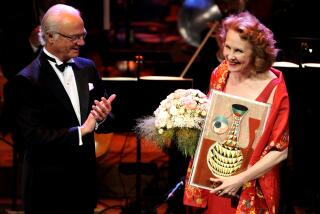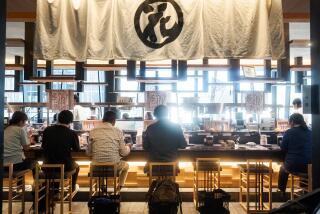MUSIC REVIEW : Tomijuro V Is Guest in Kabuki Program
- Share via
Rich in ceremony and distinguished musicianship, the 35th anniversary program of Kabuki dance by the students of the late Kanya Sanjo V also boasted a stellar guest from the Grand Kabuki itself, Saturday at the Japan America Theatre.
Tomijuro Nakamura V had led the 1986 Grand Kabuki tour of the U.S., and this return visit both honored his hosts and reminded local audiences of his extraordinary vigor and dexterity as a dancer. The solo “Tomo Yakko” proved especially fascinating because of its mix of conventionalized dance movement and relatively realistic gesture.
Wearing a short, skirtlike garment over white leggings, Tomijuro stepped with unexpected lightness, knees pulled high into the air, accenting these soft footfalls with expressive hand motifs and an occasional stamp. Soon the vocabulary grew virtuosic: hops on one foot, steps executed while kneeling and sitting, plus, finally, complex rhythmic patterns pounded out in place.
As the curtain fell, Tomijuro struck a classic Kabuki pose: holding a paper lantern high over his head with one hand, slapping his chest with the other and then clenching his fist while grimacing intently.
This meticulously shaped and shaded ferocity also informed his performance of the battle duet “Gojo Bashi” opposite the superbly coached Maika Fujima--both in magnificent stiff and wide costumes that heightened the ritualistic formality of the movement.
Student performers dominated the rest of the program. Twelve women fluttered powder-blue fans and flowed through countless arbitrary groupings in Tazo Fujima’s “Nagare.” Three more decoratively wielded flowering branches and golden tassels in “Haru No Shirabe.” And Kanfuji Sanjo, Kan-oh Sanjo and Kanshizu Sanjo--dancers who have taken the name of their teacher--appeared in “Hinazuru Sambaso,” a traditional offering dance.
Grand Kabuki choreographer Tazo Fujima joined Kangiku Sanjo in “Shizuhata Obi,” a divertissement derived from the sublime Noh tragedy “Sumidagawa.” Their solos and interplay looked artful enough, yet much of the emotional power and stylistic refinement in this and other selections came from the musicians: a nagauta ensemble headed by Yajuro Kineya IV and Sakichi Kineya V.
More to Read
The biggest entertainment stories
Get our big stories about Hollywood, film, television, music, arts, culture and more right in your inbox as soon as they publish.
You may occasionally receive promotional content from the Los Angeles Times.










